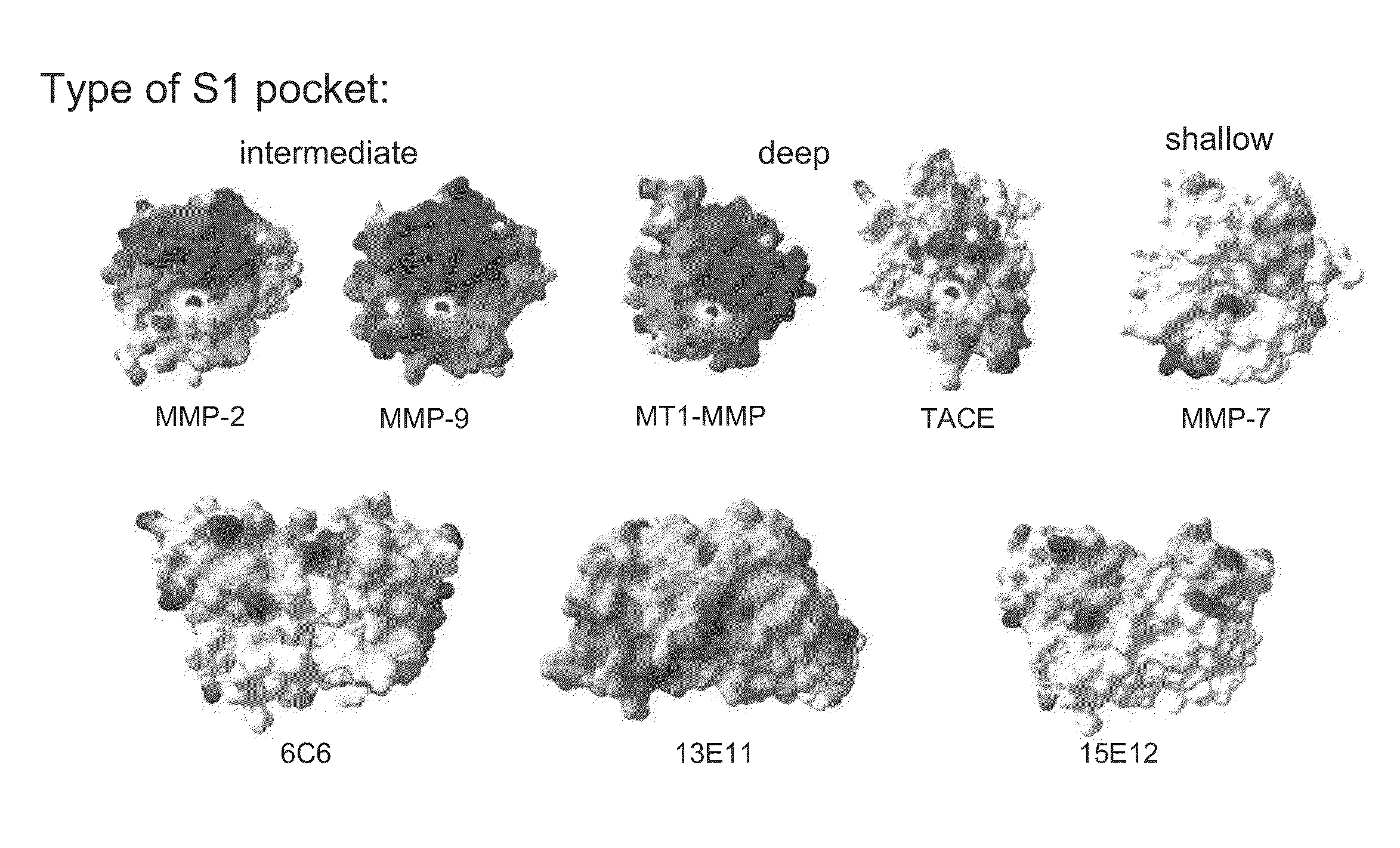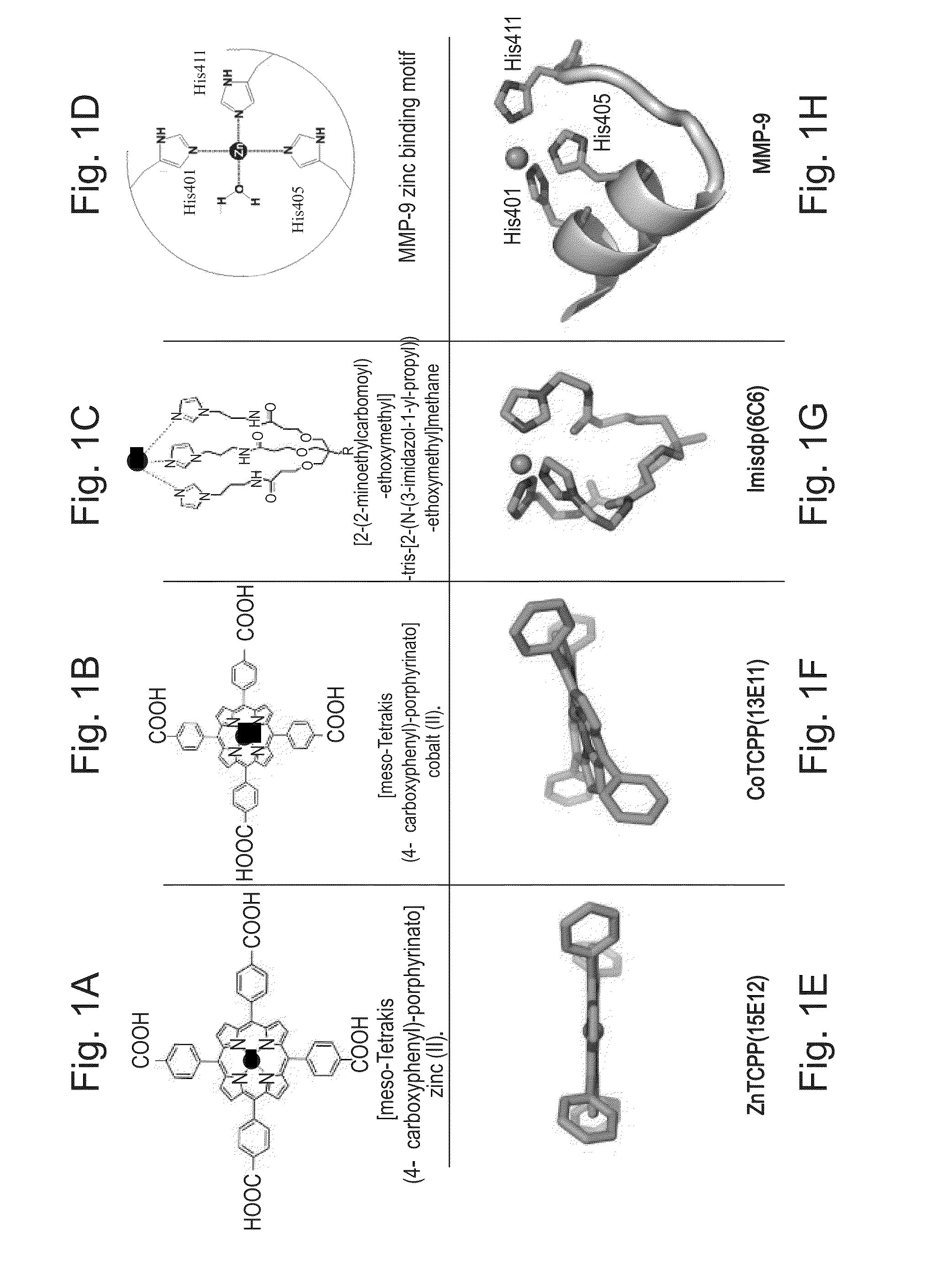Antibodies and pharmaceutical compositions containing same useful for inhibiting activity of metalloproteins
a technology of metalloproteins and antibodies, applied in the field of hapten molecules and antibodies, can solve the problems of uncontrolled breakdown of connective tissue by metalloproteases, limited clinical use of peptide-based mmp inhibitors, and high cost of peptide-based hydroxamate production
- Summary
- Abstract
- Description
- Claims
- Application Information
AI Technical Summary
Benefits of technology
Problems solved by technology
Method used
Image
Examples
example 1
Conformational Mimcry of the Zinc Active Site by Small Organometalic Compounds
[0198]The zinc ion in the active site of MMPs is uniformly coordinated by three conserved histidine residues. During zymogen activation and substrate proteolysis zinc coordination varies from 4-coordination, tetrahedral geometry, in the non catalytic stages to 5-coordination, trigonal bipyramidal Auld, D. S., Zinc coordination sphere in biochemical zinc sites. Biometals, 2001. 14(3-4): p. 271-313] in the catalytic stages. The conserved histidines can therefore assume different geometries with respect to the zinc ion. To sample these conformations, two compounds were selected as models for zinc environment mimicry Imisdp and Co / ZnTCPP (FIG. 1). Imisdp (synthesis is provided in Example 7 below) compound can mimic the 4-coordination geometry. In this case, a nearly tetrahedral conformation is formed by three imidazole bases and water molecule as the fourth ligand.
[0199]FIG. 2A shows an overlay of the construc...
example 2
Monoclonal Antibodies Generation and Selection
[0200]Monoclonal antibodies against CoTCPP, ZnTCPP and Imisdp (FIG. 1) were produced by immunization of mice and selection of specific antibodies by an ELISA screen with the respective compound as the coated antigen. Three antibodies were selected for extensive study. Notably, these clones were chosen because they displayed the best affinity toward their immunizing hapten respectively, based on competitive ELISA screen. Their binding constants, ranging from 0.01-0.09 nM, (Table 3, below), are characteristic of high affinity mAbs. MAbs were propagated as ascites in mice and purified with protein G beads.
TABLE 3summary of isotype and ELISA competition analysis of anti-CoTCPP,ZnTCPP and Imisdp monoclonal antibodies.ImmunizingHaptenAntibody IsotypeKd [μM]*NameCoTCPPIgG2b0.0913E11ZnTCPPIgG2a0.0115E12ImisdpIgG2a0.096C6*Binding affinities (Kd) of the antibodies toward their immunizing hapten were determined by competitive ELISA (for details, se...
example 3
Monoclonal Antibodies Cross React with MMP-2 and MMP-9
[0201]To determine whether mAbs raised against synthetic compounds that mimic the zinc histidine conformation in the catalytic site of MMPs, cross react with the exposed zinc histidine motif within the active sites of MMP-2 and MMP-9, monoclonal antibodies were first screened for binding MMP-9 using direct ELISA.
[0202]The three mAbs bound MMP-9 catalytic domain directly adsorbed to microtiter plate wells (commercial anti MMP-9 antibody served as positive control and unrelated IgG served as negative control). Interestingly, mAbs that have been propogated as ascites in mice co purified with active MMP-9 present in mice ascites fluid. Western blot analysis, of the purified antibodies alone, with anti MMP-9 antibody as the primary antibody showed a clear band corresponding to the expected molecular mass of about 82 KDa for active MMP-9. Thus, mAbs formed a complex in vivo with the native enzyme.
[0203]Monoclonal antibodies were next s...
PUM
 Login to View More
Login to View More Abstract
Description
Claims
Application Information
 Login to View More
Login to View More - R&D
- Intellectual Property
- Life Sciences
- Materials
- Tech Scout
- Unparalleled Data Quality
- Higher Quality Content
- 60% Fewer Hallucinations
Browse by: Latest US Patents, China's latest patents, Technical Efficacy Thesaurus, Application Domain, Technology Topic, Popular Technical Reports.
© 2025 PatSnap. All rights reserved.Legal|Privacy policy|Modern Slavery Act Transparency Statement|Sitemap|About US| Contact US: help@patsnap.com



